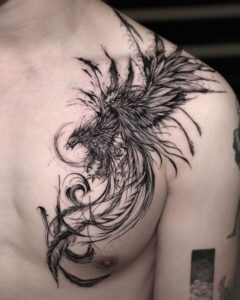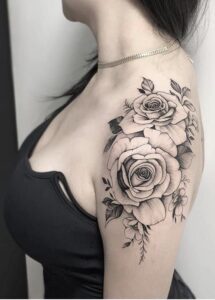Exploring Tattoo Styles: History, Meanings, and the Art of Self-Expression
Tattooing is an ancient practice that has evolved into a dynamic art form with countless tattoo styles to choose from. Whether you’re a seasoned collector or contemplating your first piece, understanding the different tattoo styles available can help you make an informed decision that reflects your personality and aesthetic preferences. In this comprehensive guide, we’ll delve into the history of tattoo styles, explore their meanings, and weigh the positives and negatives of getting a tattoo. By the end, you’ll have a clearer understanding of what tattoo style suits you best.


The Rich History of Tattoo Styles
The practice of tattooing is as old as human civilization itself, with roots that stretch back thousands of years. Tattoo styles have been influenced by cultural, social, and religious factors, and each style tells a unique story.
Ancient Tattoo Traditions
Tattooing has been practiced by many ancient civilizations, each developing distinct tattoo styles with deep cultural significance. The earliest evidence of tattooing dates back to 5,000 years ago, found on the preserved skin of mummies. These ancient tattoo styles were often used for protection, spiritual purposes, or as a mark of social status.
In ancient Egypt, tattoos were believed to have protective qualities and were often placed on the bodies of the dead to guard them in the afterlife. The Egyptians used simple geometric designs and symbols, laying the groundwork for what would later evolve into more complex tattoo styles.


Polynesian and Maori Styles
The Polynesians are known for their intricate and symbolic tattoo styles, which have been passed down through generations. In Polynesian culture, tattoos are deeply intertwined with identity, heritage, and social status. These tattoo styles often feature patterns that represent the wearer’s ancestry, achievements, and spiritual beliefs.
These tattoos were more than just body art; they were a rite of passage and a mark of rank and prestige. Maori tattoo styles are characterized by spiral and curvilinear patterns, often applied to the face, which is considered the most sacred part of the body.
Japanese Styles
Japanese tattooing, has a rich history that dates back to at least the 5th century. Initially, tattoos were used as a form of punishment, but over time, they became an integral part of Japanese culture and art. Traditional Japanese tattoo style are known for their large, intricate designs that often cover the entire back, arms, and legs.\


tattoos typically depict scenes from nature, mythology, or folklore, with common motifs including dragons, koi fish, cherry blossoms, and tigers. The vibrant colors and detailed shading techniques used in Japanese tattoo styles have influenced tattoo artists worldwide.
Western Style
Tattooing in the Western world has a more recent history, but it has grown rapidly in popularity since the 19th century. Early Western tattoo styles were simple and functional, often used by sailors to mark their travels and experiences. These traditional American tattoos, also known as “old-school” tattoos, are characterized by bold lines, limited color palettes, and iconic symbols like anchors, roses, and eagles.
As tattooing became more mainstream in the 20th century, new tattoo styles began to emerge, influenced by various art movements and cultural trends. Today, Western tattoo styles are incredibly diverse, encompassing everything from minimalist designs to hyper-realistic portraits.
A Closer Look at Popular Tattoo Style Today
With such a wide range of tattoo styles to choose from, it can be overwhelming to decide which one is right for you. Here, we’ll explore some of the most popular tattoo styles that have captured the imagination of tattoo enthusiasts worldwide.

Traditional Styles
Traditional tattoo styles, also known as “old-school” tattoos, are rooted in the early days of Western tattooing. These tattoos are characterized by their bold, black outlines, simple color schemes, and iconic imagery. Common motifs in traditional tattoo styles include anchors, roses, hearts, skulls, and pin-up girls.
One of the key features of traditional tattoo styles is their durability. The bold lines and simple designs hold up well over time, making them a popular choice for those who want a tattoo that will age gracefully. Traditional tattoos also have a timeless appeal, evoking a sense of nostalgia for the early days of tattooing.
Neo-Traditional Styles
Neo-traditional tattoo styles are a modern evolution of the traditional tattoo, blending the bold lines and iconic imagery of old-school tattoos with more intricate details and a wider color palette. These tattoos often feature more elaborate shading and highlighting techniques, giving them a more three-dimensional appearance.
While neo-traditional tattoo styles retain the classic motifs of traditional tattoos, such as roses, daggers, and animals, they also incorporate contemporary subjects and artistic influences. This makes them a versatile option for those who appreciate the boldness of traditional tattoos but want something more personalized and modern.

Realism Styles
Realism tattoos are all about capturing real-life images with astonishing accuracy and detail. These tattoo styles aim to replicate photographs or paintings on the skin, often resulting in stunning portraits, wildlife scenes, or even lifelike depictions of objects.
Creating a realism tattoo requires a high level of skill and precision, as the artist must pay close attention to details such as shadows, textures, and light sources. Realism tattoo styles are particularly popular for memorial tattoos, as they can create a lasting tribute to a loved one or a cherished pet.
Watercolor Styles
Watercolor tattoos are a relatively new trend in the world of tattooing, but they have quickly gained popularity for their unique and artistic appearance. These tattoo styles mimic the look of watercolor paintings, using soft, blended colors and brushstroke-like techniques.
One of the defining features of watercolor tattoo styles is the absence of traditional black outlines. Instead, the colors blend seamlessly into the skin, creating a more fluid and organic look. Watercolor tattoos are often used for floral designs, abstract art, or reimagined versions of traditional tattoo motifs.


Tribal Styles
Tribal tattoos are some of the oldest tattoo styles in the world, with roots in the ancient traditions of indigenous cultures. These tattoos typically feature bold, black lines and geometric patterns that hold deep cultural and spiritual meanings.
Each tribal tattoo style is unique to the culture it originates from, with designs often representing the wearer’s ancestry, achievements, and spiritual beliefs. For example, Polynesian tribal tattoos are known for their intricate patterns and symbolism, while Maori tattoos often feature spiral motifs that represent the cycle of life.
Tribal tattoo styles have become popular in modern times for their striking appearance and connection to ancient traditions. However, it’s important to approach these tattoos with respect for their cultural significance and origins.


Geometric Styles
Geometric tattoos focus on the use of lines, shapes, and symmetry to create designs that are both visually striking and meaningful. These tattoo styles can range from simple, minimalist designs to complex, abstract patterns that cover large areas of the body.
Geometric tattoos are often inspired by mathematical principles and natural patterns, such as the Fibonacci sequence or the hexagonal structure of honeycombs. These tattoos are popular for their clean, modern look and the sense of balance and harmony they convey.
Black work Styles
Black work tattoos are defined by their use of solid black ink to create bold, often dramatic designs. These tattoo styles can range from simple, minimalist shapes to intricate patterns that cover large areas of the body.
One of the key advantages of black work tattoo styles is their versatility. The use of black ink allows for a wide range of design possibilities, from geometric patterns to tribal motifs or even large-scale abstract art. Black work tattoos are also known for their longevity, as black ink tends to hold up well over time.


Dot work Tattoo Styles
Dot work tattoos are created using hundreds or thousands of tiny dots to form intricate patterns or images. These tattoo styles are often used for geometric designs, mandalas, or even portraits, with the dots varying in size and spacing to create different shades and textures.
Dot work tattoos require a high level of precision and patience, as each dot must be carefully placed to achieve the desired effect. These tattoos are popular for their unique, textured appearance and the sense of depth and detail they can create.
Script and Typography Styles
Script and typography tattoos focus on the beauty of the written word, using text rather than images to convey a message or tell a story. These tattoo styles can range from simple names or dates to elaborate quotes, poems, or even entire passages from books.
The choice of font and style is crucial in script and typography tattoos, as it can greatly influence the overall look and feel of the design. Whether you prefer elegant cursive, bold block letters, or something more artistic, these tattoo styles offer endless possibilities for personalization.

The Positive Aspects of Tattoo Styles
Tattoos have become a widely accepted form of self-expression, and choosing the right tattoo style can bring a number of positive benefits. Here are some of the advantages of getting a tattoo that reflects your personal style.
Self-Expression and Identity
One of the most significant benefits of tattoos is their ability to express your individuality. With so many tattoo styles to choose from, you can find a design that perfectly captures your personality, beliefs, and life experiences.
Tattoos can serve as a powerful form of self-expression, allowing you to display what matters most to you on your skin. Whether you choose a bold, traditional design or a delicate, watercolor piece, your tattoo becomes a permanent statement of who you are.
Cultural and Spiritual Significance
For many people, tattoos go beyond mere decoration; they carry deep cultural or spiritual meaning. Tribal tattoo styles, for instance, are often tied to the wearer’s heritage and can symbolize everything from social status to spiritual beliefs. In some cultures, getting a tattoo is seen as a rite of passage, marking significant life events or personal achievements.
Religious and spiritual tattoos are another way people use body art to connect with their faith. These tattoos might include symbols like crosses, mandalas, or sacred texts, serving as a daily reminder of one’s beliefs and values. Choosing a tattoo style that aligns with your spiritual or cultural background can make the experience even more meaningful.

Artistic Value
Tattoos are a form of art, and many people appreciate them purely for their aesthetic value. Tattoo artists are skilled professionals who use the human body as their canvas, creating intricate designs that can rival traditional forms of art. Certain tattoo styles, such as realism or Japanese require a high level of artistic skill and precision, making them particularly admired in the tattoo community.
The artistic value of tattoos is also seen in the collaboration between the artist and the client. When you choose a tattoo style, you are not just selecting an image; you are participating in a creative process. The result is a unique piece of art that you carry with you every day.
Commemoration and Memory
Tattoos are often used to commemorate significant events, people, or experiences in one’s life. Memorial tattoos, which typically use realism or script styles, allow people to honor loved ones who have passed away. These tattoos serve as a permanent tribute, providing comfort and a way to keep the memory of the deceased close.
Other commemorative tattoos might mark milestones such as the birth of a child, a significant personal achievement, or a life-changing journey. Tattoo styles like dot work or geometric designs can be used to create abstract representations of these memories, offering a more subtle way to remember important moments.

The Negative Aspects of Tattoo Styles
While tattoos offer many benefits, there are also some potential downsides to consider. It’s important to weigh these factors before deciding on a tattoo style and committing to a permanent piece of body art.
Permanence and Regret
The most obvious drawback of tattoos is their permanence. Once a tattoo is inked onto your skin, it is there for life, unless you opt for removal, which can be costly and painful. Some tattoo styles, particularly those with bold lines or dark colors, are more difficult to remove or cover up than others.
This permanence can lead to regret, especially if you choose a tattoo style that you later feel no longer represents you. Trends in tattoo styles come and go, and what might seem like a great idea today could feel outdated or irrelevant in the future. It’s important to choose a tattoo style that you believe will stand the test of time and continue to hold meaning for you.
Health Risks
Tattooing involves puncturing the skin with needles, which carries inherent health risks. Infections, allergic reactions, and scarring are all possible complications, particularly if the tattoo is not done in a clean and professional environment. Some tattoo styles, like those involving heavy shading or large, intricate designs, may require multiple sessions, increasing the risk of adverse reactions.

Additionally, certain inks used in tattoo styles may contain substances that can cause allergic reactions or other health issues. It’s important to discuss any concerns with your tattoo artist beforehand and ensure they use high-quality, safe materials.
Social Stigma and Professional Challenges
Despite tattoos becoming more mainstream, they can still carry a social stigma in certain environments. This is particularly true for visible tattoos, such as those on the hands, neck, or face. Depending on the tattoo style and placement, you might face discrimination or judgment in professional settings, particularly in more conservative industries.
Some employers have policies against visible tattoos, and even in more relaxed workplaces, certain tattoo styles might not be well-received. If you work in or plan to enter a profession where tattoos are not widely accepted, it’s important to consider how your tattoo might affect your career prospects.
Aging and Fading
Over time, all tattoos will age, and some tattoo are more prone to fading or distortion than others. Factors like sun exposure, skin type, and the quality of the ink used can all affect how well a tattoo ages. For example, watercolor tattoo styles, which lack the traditional black outlines, may fade more quickly and lose their definition.
As your skin ages, it also changes, which can impact the appearance of your tattoo. Weight fluctuations, wrinkles, and other changes in skin texture can cause the tattoo to stretch, blur, or lose its original shape. It’s important to choose a tattoo style that you believe will age well with you and to take proper care of your tattoo to maintain its appearance.


How to Choose the Right Tattoo Style for You
With so many tattoo styles available, choosing the right one can feel overwhelming. However, by considering a few key factors, you can make a decision that you will be happy with for years to come.
Reflect on Your Personality and Interests
Your tattoo should be a reflection of who you are. Consider your interests, hobbies, and values when choosing a tattoo style. For example, if you’re passionate about nature, you might gravitate toward floral or animal designs. If you’re drawn to clean, modern aesthetics, geometric or minimalist tattoo might be more your speed.
Think about what you want your tattoo to represent. Do you want it to symbolize something important in your life, commemorate a significant event, or simply be a piece of art that you enjoy looking at? Understanding your motivations will help you choose a tattoo style that aligns with your goals.
Do Your Research on Styles
Before settling on a tattoo style, take the time to research different options. Look at portfolios from various tattoo artists to see examples of their work and to get a sense of what each style looks like on the skin. It’s also helpful to read about the history and meaning behind different tattoo styles, as this can add depth and significance to your choice.
Consider how different tattoo styles might look on different parts of your body. Some styles, like realism or Japanese work best on larger areas like the back or chest, while smaller, simpler designs might be better suited for the wrist or ankle.


Consult with a Professional Tattoo Artist
Once you have an idea of what you want, consult with a professional tattoo artist who specializes in the style you’re interested in. A skilled artist can offer valuable insights into how the design will look on your body, suggest modifications to suit your anatomy, and ensure that the tattoo is executed with precision and care.
It’s important to choose an artist whose work you admire and who you feel comfortable with. The right artist will not only bring your vision to life but will also help you avoid common pitfalls, such as choosing a design that might not age well or selecting a placement that could cause the tattoo to warp over time.
Consider the Long-Term Implications
Tattoos are a long-term commitment, so it’s important to think about how your chosen tattoo style will impact your future. Consider how the tattoo might age, both in terms of the design itself and how it will look as your skin changes over time. Some tattoo styles, like black work or traditional tattoos, are known for their longevity, while others, like watercolor, may require more maintenance to keep them looking fresh.
It’s also worth considering how your tattoo might be perceived by others in different stages of your life. While it’s important to choose a tattoo that makes you happy, it’s also wise to think about how it might fit into your professional and personal life as you grow older.
Plan for Aftercare and Maintenance
Aftercare is a crucial part of ensuring that your tattoo heals properly and maintains its appearance over time. Different tattoo styles may require slightly different aftercare routines, so be sure to follow your artist’s instructions closely. This typically includes keeping the tattoo clean, moisturized, and protected from the sun during the healing process.
Long-term maintenance is also important, especially for tattoo styles that are prone to fading. Regularly applying sunscreen to your tattoo, staying hydrated, and avoiding harsh skin products can all help keep your tattoo looking its best.